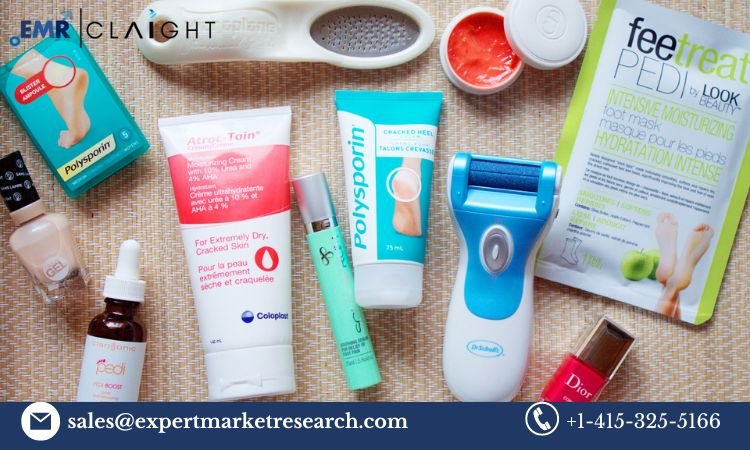The global foot care products market size attained a value of about USD 3.84 billion in 2023. The market is expected to witness a healthy CAGR of 7.1% during the forecast period of 2024-2032 to reach nearly USD 7.13 billion by 2032. This significant growth reflects a rising awareness about foot health and hygiene, which is increasingly becoming a priority for consumers globally. With products ranging from foot repair ointments to exfoliating scrubs and creams, the demand for foot care solutions is expanding rapidly. This blog post explores the various factors driving this growth, market trends, and the emerging segments within the global foot care products industry.
Market Segmentation of Foot Care Products
By Product
Foot Repair Ointments
Foot repair ointments play a crucial role in treating common foot problems such as cracked heels, calluses, and dry skin. They are designed to provide deep nourishment and restore moisture to the skin. Key ingredients like shea butter, urea, and glycerin are commonly found in these ointments, providing healing properties for the skin. Consumers are increasingly turning to foot repair products to address specific foot conditions, such as dry skin caused by environmental factors, long hours of standing, or wearing improper footwear.
Foot Creams
Foot creams have become one of the most popular foot care products, with various formulations addressing specific needs, such as moisturizing, soothing, or anti-aging effects. These creams are often marketed as part of a daily foot care regimen. The popularity of organic and natural ingredients in foot creams is rising, driven by the demand for cleaner, more sustainable products. This shift towards more eco-friendly formulations is fueling the market’s expansion.
Foot Cleansing Lotions
Foot cleansing lotions are essential for maintaining foot hygiene. These lotions help cleanse the feet, remove odors, and refresh tired feet, making them an essential part of many individuals’ daily routines. With growing concerns over foot health, these products are becoming a staple in households. The rise in awareness regarding the importance of foot hygiene has led to an increase in the demand for foot cleansing products, particularly in urban areas.
Slough Scrub Products
Exfoliating products like foot scrubs help remove dead skin and promote smooth, healthy feet. Ingredients like pumice, sea salt, and glycolic acid are often found in foot scrubs, making them effective for removing rough skin and stimulating circulation. With the growing popularity of self-care routines, foot scrubs have become a must-have item for individuals seeking to improve the health and appearance of their feet.
Others
Other emerging foot care products include foot masks, gels, and sprays. These products cater to specific needs, such as relaxation, foot fatigue relief, or deep nourishment. Foot masks, for example, are gaining popularity for their ability to deliver intensive hydration and repair damaged skin, while foot sprays provide instant relief and cooling effects after long periods of standing or walking.
By Application
Personal Use
Foot care is increasingly viewed as an integral part of personal hygiene. Many consumers incorporate foot care products into their daily routines to maintain cleanliness, moisture, and overall foot health. From moisturizing creams to protective ointments, foot care products are used to prevent conditions like athlete’s foot, fungal infections, and cracked heels. As people become more aware of the importance of foot health, personal foot care continues to drive market demand.
Clinical/Medical Use
Foot care products are also widely used in medical settings, particularly for diabetic patients who are prone to foot ulcers and other complications. Specialized foot care items, such as antifungal treatments and diabetic foot creams, are crucial for managing medical conditions that affect the feet. The growing aging population and increasing prevalence of diabetes are key factors contributing to the rise of foot care products in the healthcare industry.
Beauty and Spa
The beauty and wellness industry has embraced foot care, offering products and services that cater to consumers looking for relaxation and rejuvenation. Foot care products in spas and beauty salons, such as foot scrubs and therapeutic creams, are essential for enhancing relaxation experiences. The growing focus on wellness and self-care is encouraging the use of foot care products in spas, salons, and wellness centers worldwide.
By Distribution Channel
Online Retail
The rise of e-commerce has played a significant role in the growth of the global foot care products market. Consumers are increasingly purchasing foot care products online due to the convenience, availability of a wide range of products, and the ability to compare prices. The growth of online platforms, such as Amazon, and specialized websites dedicated to personal care products, has allowed brands to reach a global customer base, contributing to the overall expansion of the market.
Offline Retail
Despite the rise of e-commerce, traditional retail channels, including pharmacies, supermarkets, and beauty stores, continue to be popular for foot care product purchases. Physical stores allow consumers to personally assess products, receive personalized recommendations, and gain access to in-store promotions.
Others
Specialized distribution channels, such as medical stores, health clubs, and direct-to-consumer brands, also play an important role in the market. These channels are particularly effective in targeting niche markets, such as diabetic patients or consumers interested in organic foot care products.
Regional Analysis
The demand for foot care products is widespread across the globe, but certain regions are showing faster growth trends.
- North America: In North America, especially the United States, there is a strong demand for foot care products due to increasing awareness of foot health and hygiene. Consumers are opting for premium foot care products with natural ingredients, and the rising popularity of e-commerce platforms further boosts market growth.
- Europe: Europe has a well-established foot care market, with increasing adoption of foot care solutions in both residential and clinical settings. Countries like Germany, the UK, and France have witnessed substantial growth, with foot care being an essential part of personal grooming and healthcare.
- Asia Pacific: In emerging markets such as India and China, foot care products are gaining traction as consumers become more health-conscious. Rising disposable incomes and increased urbanization are contributing to the demand for quality foot care products in these regions.
- Latin America and Middle East & Africa: The market in these regions is witnessing gradual growth due to a rising focus on personal hygiene and increasing demand for premium foot care products in spas and wellness centers.
Market Dynamics
SWOT Analysis
- Strengths: The growing awareness of foot health and hygiene, combined with an expanding e-commerce sector, creates a favorable environment for market growth. Additionally, innovations in product formulations and the increasing demand for organic and natural ingredients are driving consumer interest.
- Weaknesses: Price sensitivity in certain regions, especially in emerging markets, may limit the adoption of premium foot care products. Additionally, the availability of home remedies and alternative treatments may pose a challenge to the market.
- Opportunities: The increasing focus on wellness and self-care presents significant opportunities for foot care brands to expand their product offerings and target new consumer segments. The rise of personalized foot care solutions and the growing demand for natural products also offer new avenues for growth.
- Threats: Intense competition from both established and emerging brands, as well as price pressure, could hinder profitability. Furthermore, the availability of alternative solutions, such as DIY remedies, may limit the uptake of commercial foot care products.
Porter’s Five Forces Analysis
- Threat of New Entrants: Moderate, as the market has low barriers to entry, but building brand recognition and trust can be challenging.
- Bargaining Power of Suppliers: Moderate, with key ingredients available from multiple suppliers, but high-quality ingredients may come with a premium price.
- Bargaining Power of Buyers: High, as consumers have many choices and can easily compare prices and products.
- Threat of Substitutes: Moderate, as home remedies or natural alternatives can replace commercial foot care products.
- Industry Rivalry: High, with numerous established brands and new entrants vying for market share.










Leave a Reply